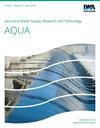Multi-scale flow regimes and driving forces analysis based on different models: a case study of the Wu river basin
IF 4.3
Q2 Environmental Science
引用次数: 1
Abstract
Quantitatively separating the influence of climate change and human activities on runoff is crucial to achieving sustainable water resource management in watersheds. This study presents a framework for quantitative assessment by integrating the indicators of hydrologic alteration, the whale optimization algorithm and random forest (WOA-RF), and the water erosion prediction (WEP-L) model. This framework aims to reconstruct natural runoff and quantify the differences in hydrological conditions and their driving forces at multi-timescales (annual, season, and month). The results indicate that the runoff of the Wu River has decreased since 2005, with a change degree of 46%. Climate factors were found to influence the interannual variation of runoff mainly. Meanwhile, human activities had a more significant impact in autumn, with a relative contribution rate of 59.0% (WOA-RF model) and 70.8% (WEP-L model). Monthly, the picture is more complex, with the results of the WOA-RF model indicating that climate change has a significant impact in July, August, and September (88.8, 92.7, and 79.3%, respectively). However, the WEP-L model results showed that the relative contribution of land use was significant in April, May, June, October, and November (51.24, 64.23, 63.63, 53.16, and 50.63%, respectively). The results of the study can be helpful for regional water allocation.基于不同模型的多尺度流态及驱动力分析——以乌河流域为例
定量区分气候变化和人类活动对径流的影响对于实现流域水资源的可持续管理至关重要。本文提出了综合水文蚀变指标、随机森林优化算法(WOA-RF)和水土流失预测模型(WEP-L)的定量评价框架。该框架旨在重建自然径流,并在多时间尺度(年、季节和月)上量化水文条件及其驱动力的差异。结果表明:2005年以来,乌河径流量呈减少趋势,变化幅度为46%;气候因子主要影响径流的年际变化。人类活动对秋季的影响更为显著,相对贡献率分别为59.0% (WOA-RF模型)和70.8% (WEP-L模型)。月度情况更为复杂,WOA-RF模式的结果表明,气候变化在7月、8月和9月的影响显著(分别为88.8、92.7和79.3%)。然而,WEP-L模型结果显示,4月、5月、6月、10月和11月土地利用的相对贡献显著(分别为51.24、64.23、63.63、53.16和50.63%)。研究结果对区域水资源配置具有一定的指导意义。
本文章由计算机程序翻译,如有差异,请以英文原文为准。
求助全文
约1分钟内获得全文
求助全文
来源期刊
CiteScore
4.70
自引率
0.00%
发文量
74
审稿时长
4.5 months
期刊介绍:
Journal of Water Supply: Research and Technology - Aqua publishes peer-reviewed scientific & technical, review, and practical/ operational papers dealing with research and development in water supply technology and management, including economics, training and public relations on a national and international level.

 求助内容:
求助内容: 应助结果提醒方式:
应助结果提醒方式:


